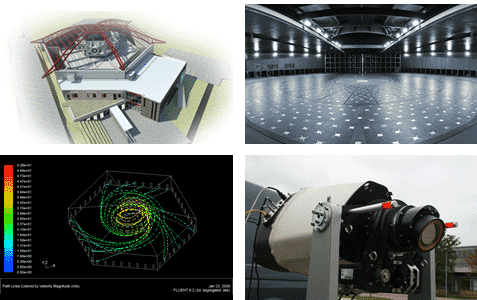3D WindScanner utilises Lidar to assess turbulence
The WindEEE Research Institute has confirmed the successful installation of a short-range 3D WindScanner, based on ZephIR Continuous Wave Lidar technology and supplied by the Wind Energy Department of the Technical University of Denmark, to study turbulence effects for wind turbines, buildings and structures.
The organisations believe it to be the first deployment of its kind, utilising the ‘best in class’ of both 3D wind-system generating wind domes and a 3D scanning wind lidar measurement sensor.
The Wind Engineering, Energy and Environment (WindEEE) Dome is the world’s first hexagonal wind tunnel. Its large scale structure (25m diameter for the inner dome and 40m diameter for the outer return dome) allows for wind simulations over extended areas and complex terrain. Uniquely, WindEEE allows for the manipulation of inflow and boundary conditions to reproduce, at large scales and under controlled conditions, the dynamics of real wind systems. By manipulating the outflow and direction of these fans, the facility is capable of producing time-dependent, straight, sheared or swirl winds of variable directionality. Therefore, a large variety of wind fields such as boundary layers, portions of hurricanes, tornados, downbursts, low level currents or gust fronts can be physically simulated.

Clockwise from top left: The WindEEE facility in Ontario; Inside the WindEEE facility; WindScanner with Continuous Wave Lidar; Flow modelling of tornado systems that can be generated in WindEEE
WindScanner’s remote sensing wind measurement methodology, with integrated syncronised 3-axis beam steering and scanning systems, provides detailed full-scale real atmospheric wind and turbulence measurements. The first of three time and space beam syncronised systems required to measure the variety of the 3D wind conditions generated by WindEEE in the most accurate way possible, with a ZephIR Continuous Wave Lidar at its core, has now been installed.
This combination of state-of-the-art technologies will help the industry understand more about the vulnerability to turbulence of wind turbines, wind farms, and other buildings and structures. With increasing rotor diameters of wind turbines the turbulent effects produced become increasingly significant in the operations, maintenance and performance of modern wind farms.
ZephIR, WindScanner and WindEEE are facing this challenge head-on, and the project has been described as ‘the necessary quantum leap forward in wind research’.
Professor Horia Hangan, Director of the WindEEE Research Institute at Western University Canada commented: “Our vision has always been to be a global leader in wind research and innovation, making a global contribution to the resilience of structures. WindEEE, our tornado generating wind dome, is now home to the world’s leading measurement system, the WindScanner, which is based on equally novel ZephIR Lidar Technology. We very much look forward to communicating the further results from our work as we progress with leading research and educational programs at Western University.”


